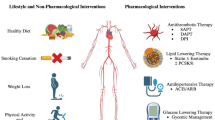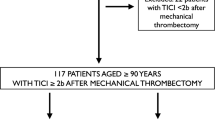Abstract
Purpose
Vascular calcification is an important risk factor for endovascular treatment failure and complications in patients with chronic limb-threatening ischemia (CLTI). Intravascular lithotripsy (IVL) is a pulsatile balloon-based device that has emerged as a tool in the treatment of calcified vessels. The purpose of this study is to evaluate the efficacy and safety of IVL in the treatment of peripheral calcified lesions in CLTI patients.
Materials and methods
A retrospective study was performed within a single institution. Thirty-six CLTI patients treated with IVL for peripheral calcified lesions from 2018 to 2022 were identified. Data on pre- and post-IVL luminal stenosis measured by digital subtraction angiography, lesion location, adjunctive therapies, ankle-brachial index (ABI), and intra-procedural complications were obtained. A total of 41 target lesions in twenty-eight patients were included, with ABI data available in 20 treated lower extremities.
Results
Across all 41 target lesions, IVL produced clinically significant luminal gain of 75.5% ± 23.0. Luminal gain by vessel location was 87.3% ± 15.8, 57% ± 25.7, and 78.5% ± 20.6 in the aortoiliac (n = 8), common femoral (n = 9), and femoropopliteal (n = 24) segments, respectively. Lesions treated with IVL alone yielded a luminal gain of 71.4% ± 25.6 (n = 10), while IVL alongside adjunctive therapy produced a luminal gain of 76.8% ± 22.4. In 20 treated lower extremities, ABI improvement of 0.20 ± 0.26 (p = 0.002) was recorded. Intra-procedural complications occurred in 1/36 patients, which was one instance of thrombus occurring prior to IVL.
Conclusion
IVL may be an effective option for creating safe luminal gain and vessel preparation in patients with CLTI.
Level of Evidence 2: Retrospective Cohort Study.



Similar content being viewed by others
References
Conte MS, Bradbury AW, Kolh P, White JV, Dick F, Fitridge R, Mills JL, Ricco JB, Suresh KR, Murad MH (2019) GVG Writing Group. Global vascular guidelines on the management of chronic limb-threatening ischemia. J Vasc Surg. 2019 Jun;69(6S):3S-125S.e40, https://doi.org/10.1016/j.jvs.2019.02.016. Erratum in: J Vasc Surg. 70(2):662. PMID: 31159978; PMCID: PMC8365864.
Nasiri A, Kim H, Gurusamy V, Benenati JF. Management of calcification: rational and technical considerations for intravascular lithotripsy. Tech Vasc Interv Radiol. 2022;25(3):100841. https://doi.org/10.1016/j.tvir.2022.100841.
Rocha-Singh KJ, Zeller T, Jaff MR. Peripheral arterial calcification: prevalence, mechanism, detection, and clinical implications. Catheter Cardiovasc Interv. 2014;83(6):E212–20. https://doi.org/10.1002/ccd.25387.
Thukkani AK, Kinlay S. Endovascular intervention for peripheral artery disease. Circ Res. 2015;116(9):1599–613. https://doi.org/10.1161/CIRCRESAHA.116.303503.PMID:25908731;PMCID:PMC4504240.
Dini CS, Tomberli B, Mattesini A, Ristalli F, Valente S, Stolcova M, Meucci F, Baldereschi G, Fanelli F, Shlofmitz RA, Ali ZA, Di Mario C. Intravascular lithotripsy for calcific coronary and peripheral artery stenoses. EuroIntervention. 2019;15(8):714–21. https://doi.org/10.4244/EIJ-D-18-01056. (PMID: 31062700).
Brodmann M, Werner M, Brinton TJ, Illindala U, Lansky A, Jaff MR, Holden A. Safety and performance of lithoplasty for treatment of calcified peripheral artery lesions. J Am Coll Cardiol. 2017;70(7):908–10. https://doi.org/10.1016/j.jacc.2017.06.022. (PMID: 28797363).
Brodmann M, Werner M, Holden A, Tepe G, Scheinert D, Schwindt A, Wolf F, Jaff M, Lansky A, Zeller T. Primary outcomes and mechanism of action of intravascular lithotripsy in calcified, femoropopliteal lesions: results of Disrupt PAD II. Catheter Cardiovasc Interv. 2019;93(2):335–42. https://doi.org/10.1002/ccd.27943. (Epub 2018 Nov 25 PMID: 30474206).
Brodmann M, Holden A, Zeller T. Safety and Feasibility of Intravascular Lithotripsy for Treatment of Below-the-Knee Arterial Stenoses. J Endovasc Ther. 2018;25(4):499–503. https://doi.org/10.1177/1526602818783989.
Adams G, Soukas PA, Mehrle A, Bertolet B, Armstrong EJ. Intravascular lithotripsy for treatment of calcified infrapopliteal lesions: results from the disrupt PAD III observational study. J Endovasc Ther. 2022;29(1):76–83. https://doi.org/10.1177/15266028211032953. (Epub 2021 Aug 12 PMID: 34380334).
Tepe G, Brodmann M, Werner M, Bachinsky W, Holden A, Zeller T, Mangalmurti S, Nolte-Ernsting C, Bertolet B, Scheinert D, Gray WA. Intravascular Lithotripsy for Peripheral Artery Calcification: 30-Day outcomes from the randomized disrupt PAD III trial. Cardiovasc Interv. 2021;14(12):1352–61.
Wong CP, Chan LP, Au DM, Chan HWC, Chan YC. Efficacy and safety of intravascular lithotripsy in lower extremity peripheral artery disease: a systematic review and meta-analysis. Eur J Vasc Endovasc Surg. 2022;63(3):446–56. https://doi.org/10.1016/j.ejvs.2021.10.035. (Epub 2021 Dec 6 PMID: 34887206).
Acknowledgements
Not applicable
Funding
This study was not supported by any funding.
Author information
Authors and Affiliations
Corresponding author
Ethics declarations
Conflicts of interest
Authors Varshana Gurusamy MD and Constantino S. Peña MD have received payment or honoraria for lectures, presentations, speakers’ bureaus, manuscript writing, or educational events from Shockwave Medical.
Consent for publication
For this type of study, consent for publication is not required.
Ethical approval.
This retrospective chart review study involving human participants was in accordance with the ethical standards of the institutional and national research committee and with the 1964 Helsinki Declaration and its later amendments or comparable ethical standards.
Informed consent
This study has obtained IRB approval from the Baptist Health South Florida IRB (approval protocol number: 1678481) and the need for informed consent was waived.
Additional information
Publisher's Note
Springer Nature remains neutral with regard to jurisdictional claims in published maps and institutional affiliations.
Rights and permissions
Springer Nature or its licensor (e.g. a society or other partner) holds exclusive rights to this article under a publishing agreement with the author(s) or other rightsholder(s); author self-archiving of the accepted manuscript version of this article is solely governed by the terms of such publishing agreement and applicable law.
About this article
Cite this article
Salazar, S.A., Vengalasetti, Y., Kilbridge, M. et al. Outcomes of Intravascular Lithotripsy in the Treatment of Chronic Limb-Threatening Ischemia: A Single-Center Retrospective Study. Cardiovasc Intervent Radiol 46, 1214–1220 (2023). https://doi.org/10.1007/s00270-023-03510-1
Received:
Accepted:
Published:
Issue Date:
DOI: https://doi.org/10.1007/s00270-023-03510-1




